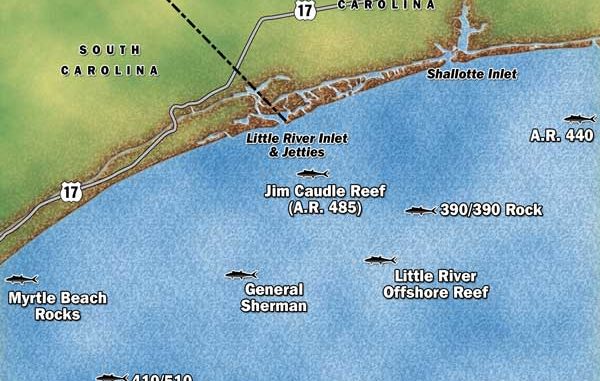
Little River mackerel action is unparalleled during the fall run.
At 5:18 p.m. on Sept. 22, fall finally arrived on the calendar. It also kicked off some spectacular king mackerel fishing in the inshore and nearshore waters around Little River Inlet.
As water temperatures fall, baitfish pour out of the inlet and pack together in tight schools, afraid to fend for themselves because countless kings and other gamefish are out there, hungrily awaiting their arrival.
Leaving the deeper reefs and livebottom areas where they’ve spent the summer, kings and other predators slip into the nearshore waters to gobble up those protein-rich baitfish that stack up along the beaches.
Little River Inlet and the surrounding waters along the South Carolina-North Carolina border are well known for their fall king mackerel run. Prime artificial reefs, wrecks and livebottom areas pepper the ocean floor within a few miles of the Little River jetties, attracting and holding million of the tasty baitfish. So Little River is ideal for the small-craft angler, providing the reel-screaming addicts with a quick way to prime fall fishing for kings.
Kings are opportunistic feeders that travel great distances across the Continental Shelf in search of easy meals. Much of their regional or local migration is dependent on the movement of their prey. Baitfish are temperature dependent; the cooling air that blankets the coastal landscape during the fall drops water temperatures, quickly ferrying loads of energy-packed chow out of the marshes and creeks.
The menhaden and mullet are favored meals for king mackerel. Menhaden and mullet spawn in estuaries in the spring and quickly grow to maturity throughout the summer. As the waters cool, the schools of young-adult menhaden and mullet join their parent schools and leave the backwaters of the estuary system — they can’t tolerate the cold water.
As cold fronts pass and the barometer falls, millions of baitfish pour out of inlets up and down the coast and start sliding southward. Their large congregations along the beaches and nearshore reefs draw large schools of king mackerel in tight to the shoreline.
“Fall king fishing is as predictable as it gets, with the large schools of pogeys (menhaden) packed tight along the beach. These schools will hold a school of kings 90 percent of the time,” said Capt. Wade Long of Little River’s Longshot Fishing Charters — a third-generation fisherman who often seems to have fish blood circulating through his system.
The three big Yamaha outboards on Long’s 36-foot Yellowfin rarely get much offshore action in October, because most of his trips for king mackerel never range more than 10 miles from the inlet, and many are well within sight of Myrtle Beach’s condo zone.
He is a firm believer in using live bait to catch kings; he prefers menhaden because they’re easy to find and net, but any live bait will suffice. If the menhaden are scattered or scarce, he’ll jig up cigar minnows with Sabiki rigs around nearshore reefs.
“While frozen baits will entice a fall king bite, live bait pulled around tightly-packed schools of baitfish is predestined to become a chomper king’s next meal,” Long said.
Finding fall kings is not difficult out of Little River Inlet. Long will scan the horizon, looking for birds picking at bait at or just under the surface as soon as he clears the end of the jetties. Kings will frequently skyrocket through schools of baitfish in the fall — a solid sign that it’s time to back off the throttle and drop in some lines.
While good action can be found just beyond the breakers, the nearshore artificial reefs and livebottom areas will almost guarantee a quick hook-up.
“The Jim Caudle, Little River Offshore, 390/390, 410/510, General Sherman, and Myrtle Beach Rocks are all productive locales during the fall,” Long said.
The reefs provide menhaden and other baitfish refuge and forage resources, but they also draw schools of hungry kings.
Tidelines are also reliable places to catch fall kings. Long prefers the falling tide, which pours water out of Little River Inlet, producing a tideline in the ocean that can extend for several miles. He pulls his baits on the edge where the two water colors meet, and he’ll concentrate on the green or clearer side. Tide lines will always hold good schools of baitfish and almost always will yield a quick strike from a king.
Long slow-trolls at 1½ miles per hour, pulling five live-bait rigs and covering all of the water column. He has a bait 50 yards behind the stern of his boat at the surface, one 25 yards from the stern at the surface, one in the prop wash, and two on downriggers at different depths. He clips the lines 50 feet behind the downrigger balls and places one bait 10 to 15 feet above the bottom and another 10 to 15 feet below the surface.
While trolling allows anglers to cover the most ground, larger kings will often be confined to specific places and not bunched up with the big schools of smaller kings. The kings that school in the fall are generally cookie-cutter fish in the 15- to 20-pound range. Bigger fish are more solitary, occurring in smaller pods.
If he’s not slow-trolling, Long will often anchor around reefs or livebottom areas, soak a block of ground-menhaden chum, and set out several balloon and/or kite rigs to attract kings.
Another king-fishing expert is Capt. Fred Rourk, a former Southern Kingfish Association competitor who operates Sweet Tea Charters out of Georgetown.
Rourk and his partner, Greg Holmes, fished competitively for five years, fishing 15 to 20 tournaments per year from Venice, La., to Morehead City, N.C. Those experiences have given Rourk a unique take on fall king fishing.
“Everyone is looking for the secret to fishing; there is only one, and it applies to all species, time on the water. Locating fish is the key, and time on the water,” he said.
Rourk hops from reef to reef in the fall, a run-and-gun method that allows him to cover a lot of water in a short amount of time. Often, the water temperatures will differ between different reefs, and that may affect where the baitfish and kings congregate.
“Water temperature will dictate the depth and how far to run. Most of the schooling fish in the fall will be ‘punks’ in the 10- to 20- pound class, but the action will be fast,” he said.
Rourk said finding fish is much more important than exactly what baits you use or how you rig them, because kings that are feeding will strike almost anything that resembles a baitfish. Live bait will work, but he prefers frozen cigar minnows or hard baits. The frozen cigar minnows and hard lures — drone spoons and cedar plugs — are pulled at around six knots, so Rourk can cover a broader area.
Whichever technique and bait you use, the screaming reels that are common during the fall king run can be hypnotic and well worth the effort.


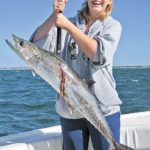
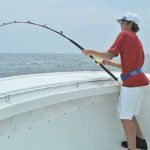
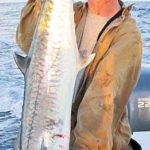
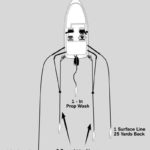
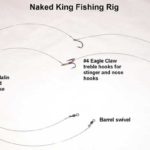



Be the first to comment